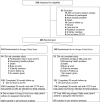Effect of Eicosapentaenoic and Docosahexaenoic Acids Added to Statin Therapy on Coronary Artery Plaque in Patients With Coronary Artery Disease: A Randomized Clinical Trial
- PMID: 29246960
- PMCID: PMC5779017
- DOI: 10.1161/JAHA.117.006981
Effect of Eicosapentaenoic and Docosahexaenoic Acids Added to Statin Therapy on Coronary Artery Plaque in Patients With Coronary Artery Disease: A Randomized Clinical Trial
Abstract
Background: Although statins reduce cardiovascular events, residual risk remains. Therefore, additional modalities are needed to reduce risk. We evaluated the effect of eicosapentaenoic acid and docosahexaenoic acid in pharmacologic doses added to statin treatment on coronary artery plaque volume.
Methods and results: A total of 285 subjects with stable coronary artery disease on statins were randomized to omega-3 ethyl-ester (1.86 g of eicosapentaenoic acid and 1.5 g of docosahexaenoic acid daily) or no omega-3 (control) for 30 months. Coronary plaque volume was assessed by coronary computed tomographic angiography. Mean (SD) age was 63.0 (7.7) years; mean low-density lipoprotein cholesterol ≤80 mg/dL. In the intention-to-treat analysis, our primary endpoint, noncalcified plaque volume, was not different between groups (P=0.14) but approached significance in the per protocol analysis (P=0.07). When stratified by age in the intention-to-treat analysis, younger omega-3 subjects had significantly less progression of the primary endpoint, noncalcified plaque (P=0.013), and fibrous, calcified and total plaque. In plaque subtype analysis, controls had significant progression of fibrous plaque compared to no change in the omega-3 ethyl-ester group (median % change [interquartile range], 5.0% [-5.7, 20.0] versus -0.1% [-12.3, 14.5], respectively; P=0.018). Among those on low-intensity statins, omega-3 ethyl-ester subjects had attenuation of fibrous plaque progression compared to controls (median % change [interquartile range], 0.3% [-12.8, 9.0] versus 4.8% [-5.1, 19.0], respectively; P=0.032). In contrast, those on high-intensity statins had no difference in plaque change in either treatment arm.
Conclusions: High-dose eicosapentaenoic acid and docosahexaenoic acid provided additional benefit to statins in preventing progression of fibrous coronary plaque in subjects adherent to therapy with well-controlled low-density lipoprotein cholesterol levels. The benefit on low-intensity statin, but not high-intensity statin, suggests that statin intensity affects plaque volume.
Clinical trial registration: URL: http://www.ClinicalTrials.gov. Unique identifier: NCT01624727.
Keywords: coronary computed tomography angiography; coronary plaque subtype; eicosapentaenoic acid; omega‐3 fatty acids; plaque progression.
© 2017 The Authors. Published on behalf of the American Heart Association, Inc., by Wiley.
Figures
References
-
- Bayturan O, Kapadia S, Nicholls SJ, Tuzcu EM, Shao M, Uno K, Shreevatsa A, Lavoie AJ, Wolski K, Schoenhagen P, Nissen SE. Clinical predictors of plaque progression despite very low levels of low‐density lipoprotein cholesterol. J Am Coll Cardiol. 2010;55:2736–2742. - PubMed
-
- Nicholls SJ, Hsu A, Wolski K, Hu B, Bayturan O, Lavoie A, Uno K, Tuzcu EM, Nissen SE. Intravascular ultrasound‐derived measures of coronary atherosclerotic plaque burden and clinical outcome. J Am Coll Cardiol. 2010;55:2399–2407. - PubMed
-
- Yokoyama M, Origasa H, Matsuzaki M, Matsuzawa Y, Saito Y, Ishikawa Y, Oikawa S, Sasaki J, Hishida H, Itakura H, Kita T, Kitabatake A, Nakaya N, Sakata T, Shimada K, Shirato K; Japan EPA lipid intervention study (JELIS) Investigators . Effects of eicosapentaenoic acid on major coronary events in hypercholesterolaemic patients (JELIS): a randomised open‐label, blinded endpoint analysis. Lancet. 2007;369:1090–1098. - PubMed
Publication types
MeSH terms
Substances
Associated data
LinkOut - more resources
Full Text Sources
Other Literature Sources
Medical


